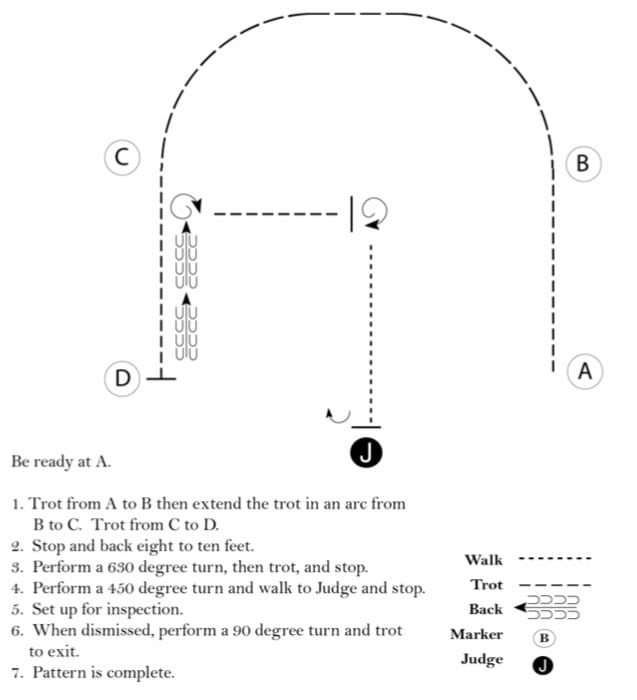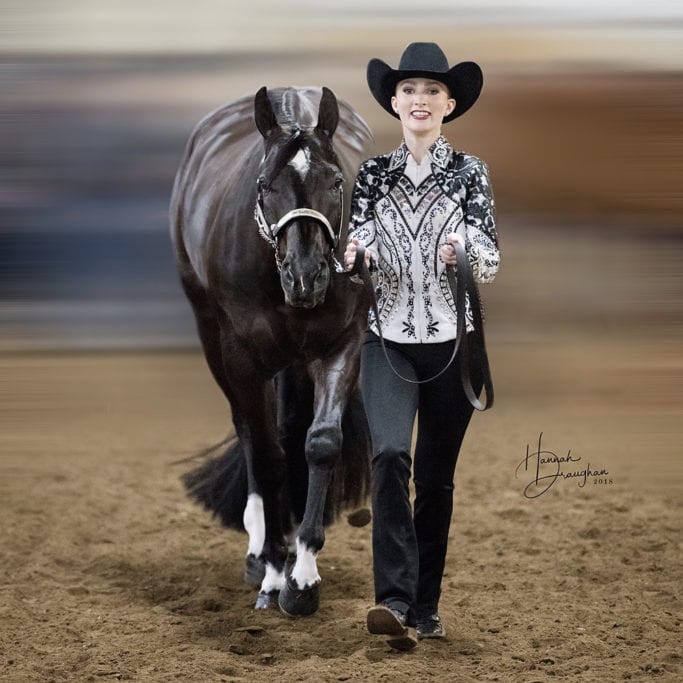GoHorseShow would like to thank Judge Daren Wright of Chillicothe, Ohio for taking the time to break down the Congress Youth 12-14, 15-18 and Amateur Showmanship patterns for us. A huge bonus is that Wright is a judge at this year’s show. As a carded AQHA judge, he has had the privilege of judging World Shows and major events all over the world.
We would also like to thank HorseShowPatterns.com for allowing us to post the pattern in the article. You may view the pattern that is displayed below or download it here. GoHorseShow chose this pattern because we thought it would be beneficial to break down one of the more challenging patterns as some of the less complicated patterns have many of the same maneuvers.
Showmanship Pattern Breakdown as seen by Daren Wright
- When approaching any showmanship pattern, the exhibitor not only needs to think about how they are going to lay out the pattern, but also think about how the judge will analyze it from a judges perspective. Knowing how the judge will evaluate each maneuver can ultimately influence your score. I firmly believe every exhibitor should read the rule book and educate themselves as much as possible on the scoring system and the fundamentals of the class.
 When reviewing this showmanship pattern, we notice that not every maneuver is done at one of the four markers. That means the exhibitor is going to have to be very aware of their position in the arena and the position of the judge to end up in the right spot for presentation.
When reviewing this showmanship pattern, we notice that not every maneuver is done at one of the four markers. That means the exhibitor is going to have to be very aware of their position in the arena and the position of the judge to end up in the right spot for presentation.- Before the class, the judges typically meet as a group to discuss the elements, any “hot spots” which are areas where mistakes may happen and the general flow and scoring of the class. Each maneuver will be scored individually, so it is important to focus on all aspects of your pattern.
- This pattern states to “be ready at A.” When the judges look up and see the exhibitor at Cone A, that is our first impression of your run and scoring starts immediately. So, it’s essential to have your horse set up, alert and well groomed, and the exhibitor is poised, confident and ready. You only have one chance to make a great first impression. This first impression is a very integral part of your pattern.
- The first maneuver of this pattern is a trot from A to B and then an extended trot arc from B to C and resuming the trot from C to D. The judges will be looking for an exhibitor that efficiently and confidentially moves right into the trot in unison with their horse. The trot-line should be straight and purposeful giving the judge a great impression of their first maneuver. The exhibitor should progress swiftly into the extended trot, again, staying in unison with their horse. Since the horse is on the outside of this arc, it will need to have a big step and be very aware of the exhibitor’s body position to keep that smooth, harmonious trot. At C, it will be essential to show a decrease in speed down to the trot, all while maintaining unity between horse and exhibitor. This spot is one to be careful that your horse does not break to the walk in that downward transition.
- The next maneuver is to stop and back six to eight feet. This is a vital element of the pattern. How well your horse stops is critical because it shows the horse’s responsiveness. The horse should stop hard and crisp and not dribble down to a stop. Once the horse is stopped, the exhibitor will get in position to back. It is very crucial to stay beside your horse and not in front of it to back. Being in front of your horse for the back will incur a “severe” penalty. The back up in this pattern can be tricky. It is essential to start and stop in unison, showing teamwork and accuracy. Some exhibitors add quite a bit of speed in their back up, but it will be important not to have so much backward momentum that you cannot stop your horse in the correct area of the pattern. Speed is great, but accuracy must come first. There is no marker to indicate where to stop, so the exhibitor will need to be very aware of their distance.
- The next maneuver is a 630-degree turn, into a trot and then a stop. The 630-degree turn will be a combination of a 360 and 270-degree turn. The turn should be crisp and smooth. The horse’s spine should be straight from hip to head, all while staying on the pivot foot. The right hind leg should remain straight up and down while executing the turn, and this will enable the horse to stay balanced on that leg and not step forward or backward. It is important to finish and close the turn, but not allowing your horse to overturn either. When finished, trot straight away and come to a decisive stop. The stop should also be in line with the judge, so when completing the next maneuver, you are directly in line to walk to the judge. The space for this maneuver is tight, so it will be essential to have your horse as responsive and willing as possible. This is another hot spot area because it will be important not to overshoot the trot and stop past the judge, making you out of line for the next maneuver.
- The next maneuver is to do a 450-degree turn and confidently and purposefully walk to the judge to set up.
- The set up will be scored individually. More and more, we see exhibitors not putting a lot of thought or accuracy into the setup. Getting your horse to set up is Showmanship 101. A quick and correct setup will always be beneficial to your score.
- The inspection should be crisp but natural. The exhibitor should be poised and sure of their timing when moving around their horse. It is acceptable to check your horse, making sure it stays square, is not resting, etc. Exhibitors should always look pleasant and look like they are enjoying what they are doing. The exhibitor should look like a horseman and stay away from anything artificial and awkward.
- The last maneuver is a 90-degree turn and trot away. After performing some big turnarounds in this pattern, this 90-degree turn may seem less important. But, rest assured, each maneuver is as essential as the other, and it is imperative that you show from the first step to the last stage of the pattern.
- Overall, we are looking for a team effort, communication between horse and exhibitor and someone who can challenge and attack the pattern. The exhibitor and horse should be confident and synchronized, showing style and accuracy. Have fun and sell this pattern to the judges. Even if you make a small mistake, never let them see you sweat. What might be a minor hiccup to you in your pattern, may not even be noticed by the judges, so it is essential to keep your game face on. As judges, we want to see you do well, we want to see you win and are your biggest cheerleaders. We don’t ever want to have to give someone last, so let us know you are there to win. Someone has to win this class, so why shouldn’t it be you?
 Daren Wright is from Chillicothe, Ohio and has been judging for close to 30 years. He holds cards with AQHA, APHA, NSBA, ApHC, PtHA, PHBA, ABRA, IBHA, and NASMA. He has judged the APHA, ApHC, PtHA, PHBA and ABRA World championship shows, AQHA Novice championships, South African, France, Swedish, Italian, Dutch and Australian Championships for AQHA, APHA, and ApHC along with many major shows throughout the world. Daren is the scholarship coordinator for Columbus State Community College, adjunct faculty for Ohio University- Southern Campus and an agent with Kaplow Equine Insurance.
Daren Wright is from Chillicothe, Ohio and has been judging for close to 30 years. He holds cards with AQHA, APHA, NSBA, ApHC, PtHA, PHBA, ABRA, IBHA, and NASMA. He has judged the APHA, ApHC, PtHA, PHBA and ABRA World championship shows, AQHA Novice championships, South African, France, Swedish, Italian, Dutch and Australian Championships for AQHA, APHA, and ApHC along with many major shows throughout the world. Daren is the scholarship coordinator for Columbus State Community College, adjunct faculty for Ohio University- Southern Campus and an agent with Kaplow Equine Insurance.







